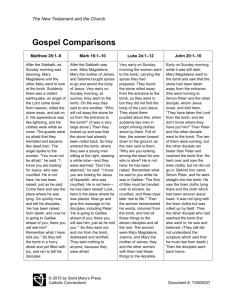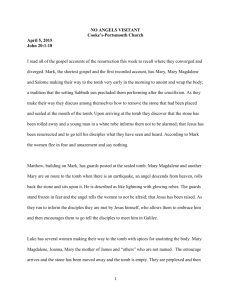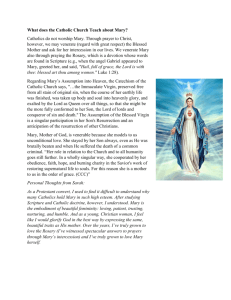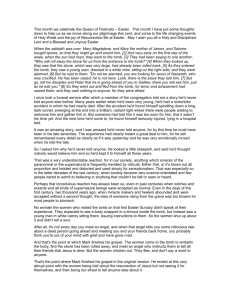Mary Magdalene After the Resurrection
advertisement
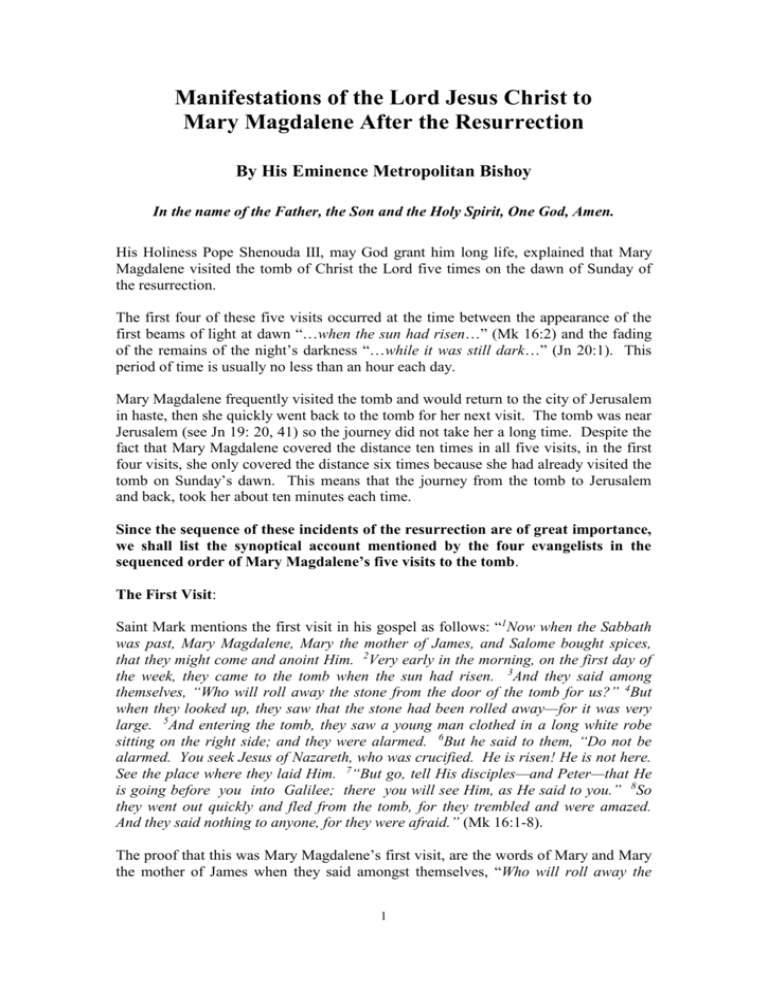
Manifestations of the Lord Jesus Christ to Mary Magdalene After the Resurrection By His Eminence Metropolitan Bishoy In the name of the Father, the Son and the Holy Spirit, One God, Amen. His Holiness Pope Shenouda III, may God grant him long life, explained that Mary Magdalene visited the tomb of Christ the Lord five times on the dawn of Sunday of the resurrection. The first four of these five visits occurred at the time between the appearance of the first beams of light at dawn “…when the sun had risen…” (Mk 16:2) and the fading of the remains of the night’s darkness “…while it was still dark…” (Jn 20:1). This period of time is usually no less than an hour each day. Mary Magdalene frequently visited the tomb and would return to the city of Jerusalem in haste, then she quickly went back to the tomb for her next visit. The tomb was near Jerusalem (see Jn 19: 20, 41) so the journey did not take her a long time. Despite the fact that Mary Magdalene covered the distance ten times in all five visits, in the first four visits, she only covered the distance six times because she had already visited the tomb on Sunday’s dawn. This means that the journey from the tomb to Jerusalem and back, took her about ten minutes each time. Since the sequence of these incidents of the resurrection are of great importance, we shall list the synoptical account mentioned by the four evangelists in the sequenced order of Mary Magdalene’s five visits to the tomb. The First Visit: Saint Mark mentions the first visit in his gospel as follows: “1Now when the Sabbath was past, Mary Magdalene, Mary the mother of James, and Salome bought spices, that they might come and anoint Him. 2Very early in the morning, on the first day of the week, they came to the tomb when the sun had risen. 3And they said among themselves, “Who will roll away the stone from the door of the tomb for us?” 4But when they looked up, they saw that the stone had been rolled away—for it was very large. 5And entering the tomb, they saw a young man clothed in a long white robe sitting on the right side; and they were alarmed. 6But he said to them, “Do not be alarmed. You seek Jesus of Nazareth, who was crucified. He is risen! He is not here. See the place where they laid Him. 7“But go, tell His disciples—and Peter—that He is going before you into Galilee; there you will see Him, as He said to you.” 8So they went out quickly and fled from the tomb, for they trembled and were amazed. And they said nothing to anyone, for they were afraid.” (Mk 16:1-8). The proof that this was Mary Magdalene’s first visit, are the words of Mary and Mary the mother of James when they said amongst themselves, “Who will roll away the 1 stone from the door of the tomb for us?” This indicates that Mary hadn’t yet seen the stone rolled away. The Second Visit: After Mary Magdalene’s return from the first visit, she did not notify anyone of what the angel told her because she was afraid. Thus, she went to see the tomb again, but this time accompanied by Saint Mary the Virgin. Saint Matthew mentioned this incident in his gospel without referring to the Virgin specifically, but he called her “…the other Mary…” He wrote, “1Now after the Sabbath, as the first day of the week began to dawn, Mary Magdalene and the other Mary came to see the tomb. 2And behold, there was a great earthquake; for an angel of the Lord descended from heaven, and came and rolled back the stone from the door, and sat on it. 3His countenance was like lightning, and his clothing as white as snow. 4And the guards shook for fear of him, and became like dead men. 5But the angel answered and said to the women, “Do not be afraid, for I know that you seek Jesus who was crucified. 6“He is not here; for He is risen, as He said. Come, see the place where the Lord lay. 7“And go quickly and tell His disciples that He is risen from the dead, and indeed He is going before you into Galilee; there you will see Him. Behold, I have told you.” 8So they went out quickly from the tomb with fear and great joy, and ran to bring His disciples word. 9And as they went to tell His disciples, behold, Jesus met them, saying, “Rejoice!” So they came and held Him by the feet and worshiped Him. 10Then Jesus said to them, “Do not be afraid. Go and tell My brethren to go to Galilee, and there they will see Me.” (Mt 1:1-10). By stating, “…behold, there was a great earthquake…”, Matthew did not mean that the earthquake occurred during this visit, but rather that it had taken place prior to both the first and second visits. Saint Mark also mentioned the second visit briefly in his gospel. It is the visit in which Mary Magdalene saw Christ the Lord, when she accompanied Saint Mary the Virgin. Saint Mark mentions this visit after mentioning the first one. His gospel states, “9Now when He rose early on the first day of the week, He appeared first to Mary Magdalene, out of whom He had cast seven demons. 10 She went and told those who had been with Him, as they mourned and wept. 11And when they heard that He was alive and had been seen by her, they did not believe.” (Mk 16: 9-11). From these verses, we can observe how Christ the Lord honored His mother, the Virgin Mother of God. He did not appear to Mary Magdalene in her first visit when she went in the company of Mary the mother of James and Salome; however, He appeared when His mother arrived. After the second visit, the will of Christ the Lord in informing His disciples about His resurrection was carried out. As Saint Matthew mentioned, they went out of the tomb “…and ran to bring His disciples word…” (Mat 28:8). It is desirable to have the companionship of Saint Mary the Virgin in our spiritual lives, in order to see Christ the Lord through the eyes of our hearts and evangelize the good news of His resurrection without hesitation. Amongst all of the saints, the Virgin is the example of complete obedience and surrender. 2 The Third Visit: After Mary Magdalene informed the disciples of the Lord’s resurrection, both she and Mary the mother of James returned to the tomb accompanied by a group of women. Saint Luke mentions this visit in his gospel after outlining the incidents relating to the burial on Friday and the rest on Saturday: “55And the women who had come with Him from Galilee followed after, and they observed the tomb and how His body was laid. 56Then they returned and prepared spices and fragrant oils. And they rested on the Sabbath according to the commandment. 1Now on the first day of the week, very early in the morning, they, and certain other women with them, came to the tomb bringing the spices which they had prepared. 2But they found the stone rolled away from the tomb. 3Then they went in and did not find the body of the Lord Jesus. 4And it happened, as they were greatly perplexed about this, that behold, two men stood by them in shining garments. 5Then, as they were afraid and bowed their faces to the earth, they said to them, “Why do you seek the living among the dead? 6“He is not here, but is risen! Remember how He spoke to you when He was still in Galilee, 7“saying, ‘The Son of Man must be delivered into the hands of sinful men, and be crucified, and the third day rise again.’ ” 8And they remembered His words. 9Then they returned from the tomb and told all these things to the eleven and to all the rest. 10It was Mary Magdalene, Joanna, Mary the mother of James, and the other women with them, who told these things to the apostles. 11And their words seemed to them like idle tales.” (Lk 23:55-24:11). Since our fathers the apostles did not believe the women, Mary Magdalene started to doubt, and so she decided to go alone to the tomb. This was the following visit. The Fourth Visit: Before the end of the night’s darkness, Mary Magdalene went to the tomb alone. Saint John the evangelist mentions this visit as follows: “1Now on the first day of the week Mary Magdalene went to the tomb early, while it was still dark, and saw that the stone had been taken away from the tomb. 2Then she ran and came to Simon Peter, and to the other disciple, whom Jesus loved, and said to them, “They have taken away the Lord out of the tomb, and we do not know where they have laid Him.” 3 Peter therefore went out, and the other disciple, and were going to the tomb. 4So they both ran together, and the other disciple outran Peter and came to the tomb first. 5 And he, stooping down and looking in, saw the linen cloths lying there; yet he did not go in. 6Then Simon Peter came, following him, and went into the tomb; and he saw the linen cloths lying there, 7and the handkerchief that had been around His head, not lying with the linen cloths, but folded together in a place by itself. 8Then the other disciple, who came to the tomb first, went in also; and he saw and believed. 9For as yet they did not know the Scripture, that He must rise again from the dead. 10Then the disciples went away again to their own homes.” (Jn 20: 1-10). Amazingly, after this visit, Mary Magdalene started repeating words that were entirely different to what she had stated after her second and third visits. After both the second and third visits, she informed the disciples that she had seen the Lord, 3 proclaimed to them His words and the words of the angels, and told them about His resurrection. However, after the fourth visit, she started repeating a phrase that echoed feelings of doubt concerning the resurrection of Christ the Lord, despite His appearance to her and the frequent appearances of the angels. She told Saints Peter and John the Apostles, “They have taken away the Lord out of the tomb, and we do not know where they have laid Him.” (Jn 20:2). Following this encounter, and the apostles’ awareness that those who guarded the tomb were no longer there, Saints Peter and John the apostles went to the tomb followed by Mary Magdalene. This was the fifth and final visit on the Sunday of the resurrection. This visit was filled with significant occurrences which completely changed the path of Mary’s life and her way of thinking. The Fifth Visit: Saint John mentions the incidents of this visit in his gospel immediately after the events mentioned in John 20:1-10. His gospel says, “11But Mary stood outside by the tomb weeping, and as she wept she stooped down and looked into the tomb. 12And she saw two angels in white sitting, one at the head and the other at the feet, where the body of Jesus had lain. 13Then they said to her, “Woman, why are you weeping?” She said to them, “Because they have taken away my Lord, and I do not know where they have laid Him.” 14Now when she had said this, she turned around and saw Jesus standing there, and did not know that it was Jesus. 15Jesus said to her, “Woman, why are you weeping? Whom are you seeking?” She, supposing Him to be the gardener, said to Him, “Sir, if You have carried Him away, tell me where You have laid Him, and I will take Him away.” 16Jesus said to her, “Mary!” She turned and said to Him, “Rabboni!” (which is to say, Teacher). 17Jesus said to her, “Do not cling to Me, for I have not yet ascended to My Father; but go to My brethren and say to them, ‘I am ascending to My Father and your Father, and to My God and your God.’ ” 18Mary Magdalene came and told the disciples that she had seen the Lord, and that He had spoken these things to her.” (Jn 20:11-18). During this fifth and final visit to the tomb, we see that Mary Magdalene was weeping, perplexed, and in doubt. She repeated the words which she had spoken to Saints Peter and John, to the angels who were sitting inside the tomb. She said, “…they have taken away my Lord, and I do not know where they have laid Him.” (Jn 20:13). Mary even spoke to Christ in the same manner when He appeared to her for the second time saying, “Sir, if You have carried Him away, tell me where You have laid Him, and I will take Him away.” (Jn 20: 15). She said this because she thought that He was the gardener and did not know that He was Christ (Jn 20: 15,14). When Christ the Lord called Mary by name saying, “Mary!” (Jn 20: 16), He wanted to reproach her for her unbelief concerning His resurrection. He wanted to rebuke her for doubting in His glorious resurrection, and also for desiring to hold on to Him. Mary wanted to hold onto Christ so He would not escape as He had previously, after she clasped His feet and worshiped Him when He appeared to her while she was accompanied by Virgin Mary (See Mt 28:9). 4 This time, reproaching her, He said, “Do not cling to Me, for I have not yet ascended to My Father.” (Jn 20: 17). This was a severe reprimand because she doubted His resurrection and wanted to hold onto Him, to prevent His disappearance once more. In doubting His resurrection, Mary also doubted Christ’s divine power to rise from the dead. She doubted that He is the Lord of life Who is equal to the heavenly Father in might, greatness, and authority. Thus, in Mary’s eyes, Christ had not reached the level of the Father. Moreover, she wanted to prevent His disappearance from her sight so that she would no longer doubt in His resurrection. It was as though she wanted to prevent His ascension into heaven. If this was her state at the time, one wonders what she would have been like after His real ascension to sit on the right hand of the Father. Thus, the Lord Jesus commanded her plainly, “Do not cling to Me, for I have not yet ascended to My Father…” (Jn 20:17). In saying this, He meant to tell His disciples: Your God (the Father) became Mine when I emptied Myself, was incarnated, and came in the image of a slave. My heavenly Father (that is, My Father by nature), will become your Father by adoption when I ascend into heaven, and send the Holy Spirit, to filial you from God through baptism. Through My descent I took what is yours, and through My ascension you shall receive what is Mine. This time, Mary Magdalene understood that she should accept the notion of Christ’s ascension (although He had not yet ascended), despite His disappearance from her sight after His resurrection. Christ remained on earth for a full 40 days from the time of the resurrection until His ascension into heaven in the presence of His disciples and saints. Therefore, “Mary Magdalene came and told the disciples that she had seen the Lord, and that He had spoken these things to her.” (Jn 20:18). Christ took away the doubt of Thomas, on the Sunday that followed the resurrection. And likewise, He took away the doubts of Mary Magdalene by appearing to her in the garden for a second time on the Sunday of the resurrection. Our Lady, the Virgin Saint Mary was marvelous and superior in her faith. She believed before she had seen Christ the Lord risen from the dead, she believed when she saw Him, and believed when she clasped His feet and worshipped Him. She accepted His ascension in complete surrender because she knew that He would sit on the right of His heavenly Father. Saint Mary understood that His kingdom is everlasting, just as the angel had announced to her before the incarnation of the Word in her womb. Thus, through the Holy Spirit, Elizabeth told her, “Blessed is she who believed, for there will be a fulfillment of those things which were told her from the Lord.” (Lk 1:45). Glory be to God forever, Amen. 5

